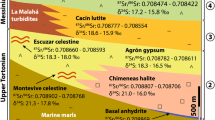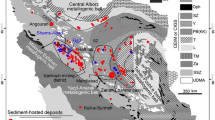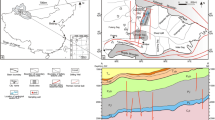Abstract
Unusually old (c. 2.4 Ga) loosely-packed anhydrite nodules and replacement nodules of gypsum, quartz and jasper are well preserved in transgressive marine siliciclastic sabkha sediment of the Huronian Gordon Lake Formation. There is no evidence of a gypsum precursor. The nodules are commonest in mud chip breccia at the base of sandstone, siltstone and mudstone upward-fining storm cycles.
Anhydrite nodules are composed of a mosaic of blocky crystals. An earlier lath form is preserved in silicified outer rims. Its texture is similar to that of Recent displacive sabkha anhydrite nodules. Siliceous nodules are composed of megaquartz, some calcite-cored, or of jasper. Megaquartz is normally anhedral with strongly undulose (flamboyant) extinction. Crystals may be columnar or crudely spheroidal. Some megaquartz crystals are lath-shaped with the oblique extinction of lutecite. Rarer euhedral megaquartz in calcite nodule cores may have simple extinction but was probably not formed by cavity filling. Megaquartz crystals and anhydrite inclusions may preserve the texture of pre-existing early anhydrite laths.
Smaller “jasper” nodules are composed of hematite-bearing fibrous fine-grained quartz, that is coarser than true jasper. Fibrous structure in this jasper may have oblique, length fast or length slow extinction, suggestive of recrystallization after lutecite, length fast and length slow chalcedony. True chert and chalcedony (<20μ) are absent. The jasper of the smaller nodules may contain ghost laths, after anhydrite? and scattered anhydrite and carbonate crystals. The jasper of larger nodules is granular. The jasper nodules contain rare gypsum crystals as well as anhydrite crystals which have been replaced to varied degrees by pseudomorphous quartz mosaics and carbonate rhombs. Some jasper nodules have an outer rim of megaquartz with anhydrite inclusions and associated carbonate. Some larger jasper nodules may have been formed in subaqueous sediments.
Some weakly-silicified anhydrite nodules have been hydrated to gypsum nodules that are connected with subhorizontal gypsum veinlets. The hydration postdates silicification and conversion of anhydrite laths to blocky anhydrite. The veinlets, probably related to late unroofing, are a possible access route for water of hydration. They are later than host-rock lithification and calcite formation in the anhydrite nodules.
Where the Gordon Lake Formation is metamorphosed megaquartz replacement nodules can be recognized by inclusions of anhydrite and interstitial calcite patches. These nodules are a useful indicator of vanished evaporites in such rocks. If the evaporite nodules of the Gordon Lake Formation, and the replaced evaporites of the Kona Dolomite of Michigan and the Peribonca Formation of Quebec are stratigraphically equivalent they indicate a cupriferous sabkha with an original extent of at least 1400 km.
Similar content being viewed by others
References
ALI, Y.A., and WEST, IAN, 1983, Relationship of modern gypsum nodules in sabkhas of loess to composition of brines and sediments in northern Egypt: Jour. of Sed. Petrology, v. 53, p. 1151–1168.
ANNELS, A.E., 1974, Some aspect of the stratiform ore deposits of the Zambian copperbelt and their genetic significancein Bartholome, P., (Ed): Gisements Stratiformes et Provinces Cupriferes: Societe Geologique de Belgique. Liege, p. 235–254
BROWN, A.C. and KIRKHAM, 1986. Guidebook, Field trip 1, Proterozoic sediment-hosted stratiform copper deposits of upper Michigan and Belt Supergroup of Idaho and Montana: Geological Association of Canada, Annual meeting, 1986, Ottawa, Ontario, 72 p.
BURGESS, I.C., and HOLLIDAY, D.W., 1974, The Permo-Triassic rocks of the Hilton Borehole, Westmoreland: Bulletin of the Geological Survey of Great Britain, v. 46, p. 1–34.
BUSH, P., 1973, Some Aspects of the Diagenetic History of the Sabkha in Abu Dhabi, Persian Gulf,in B.H. Purser, (Ed.): The Persian Gulf, Holocene Carbonate sedimentation in a Shallow Epicontinental Sea. Springer-Verlag, p. 395–407.
BUTLER, G.P., 1969, Modern Evaporite Deposition and Geochemistry of Coexisting Brines, the Sabkha, Trucial Coast, Arabian Gulf: Jour. of Sed. Petrology, v. 39, p. 70–89.
CARD, K.D., 1976, Geology of the McGregor Bay, Bay of Islands Area, Districts of Sudbury and Manitoulin: Ontario Division of Mines, Geoscience Report v. 138. 63 p.
CARD, K.D., 1978, Geology of the Sudbury-Manitoulin area, Districts of Sudbury and Manitoulin: Ontario Geological Survey, Report 166, 239 p.
CHANDLER, F.W., 1978, Geology of part of the Wollaston Lake Fold Belt, north Wollaston Lake, Saskatchewan: Geological Survey of Canada, Bulletin 277, 25 p.
CHANDLER, F.W., 1984, Sedimentary setting of an Early Proterozoic copper occurrence in the Cobalt Group, Ontario: preliminary assessment,in: Current Research, Part A, Geological Survey of Canada, Paper 84-1A, p. 185–192.
CHANDLER, F.W., 1986, Sedimentology and paleoclimatology of the Huronian (Early Aphebian) Lorrain and Gordon Lake Formations and their bearing on models for sedimentary copper mineralization,in: Current Research, Part A, Geological Survey of Canada, Paper 86-1A, p. 121–132.
CHANDLER, F.W., in press, Lower Proterozoic sabkha-related copper mineralization: paleoenvironment and diagenesis, Cobre Lake, Ontario, in: R.R. Boyle (Ed.), Sedimenthosted stratiform copper deposits: Geological Association of Canada, Special Paper.
Chowns, T.M., and Elkins, J.E., 1974, The origin of quartz geodes and cauliflower cherts through silicification of anhydrite nodules: Jour. of Sed. Petrology, v. 44, p. 885–903.
CORFU, F., and ANDREWS, A.J., 1986, A U-Pb age for mineralized Nipissing Diabase, Gowganda, Ontario: Canadian Journal of Earth Sciences, v. 23, p. 107–109.
CRICK, I.H., and MUIR, M.D., 1980, Evaporites and uranium mineralization in the Pine Creek Geosyncline, in John Ferguson and Ann B. Goleby (Eds.), Uranium in the Pine Creek Geosyncline, proceedings of the International uranium symposium on the Pine Creek Geosyncline. International Atomic Energy Agency, Vienna, p. 531–542.
DUNLOP, J.S.R., GROVES, D.I., and BUICK ROGER, 1979, Evidence for Archean evaporites: Open Earth v. 6, p. 15–16.
EISBACHER, G.H. and BIELENSTEIN, H.U, 1969, The Flack Lake Depression, Elliot Lake Area,in Report of Activities, Part B: Geological Survey of Canada, paper 69-1B, p. 58–60.
FLOOD, P.G. and WALBRAN, P.D., 1986, A silicic coastal sabkha, Capricorn Coast, Queensland, Australia: Sedimentary Geology, v. 48, p. 169–181.
FOLK, R.L., and PITTMAN, J.S., 1971, Lengthslow chalcedony: a new testament for vanished evaporites: Jour. of Sed. Petrology, v. 41, p. 1045–1058.
FRARY, M.J., 1977, Geology of the Huronian Belt between Sault Ste. Marie and Blind River, Ontario: Geological Survey of Canada, Memoir 383, 87 pp.
FRIEDMAN, G.M. and RADKE, BRUCE, 1979, Evidence for Sabkha Overprint and conditions of intermittent emergence in Cambro-Ordovician carbonates of eastern North America and Queensland, Australia: Northeastern Geology, v. 1, p. 18–42.
HOLLIDAY, D.W., 1968, Early Diagenesis in middle Carboniferous nodular anhydrite of Spitzbergen. Proceedings of the Yorkshire Geological Society, v. 36, p. 277–292.
HOLLIDAY, D.W., 1970, The petrology of secondary gypsum rocks: a review: Jour. of Sed. Petrology, v. 40, p. 734–744.
HOVORKA, S.D., 1983, Petrographic criteria for recognizing poet-Permian dissolution of evaporites, Donley County, Texas in: Geology and Geohydrology of the Palo Duro Basin, Texas Panhandle, A report on the Progress of Nuclear Waste Isolation Feasibility Studies (1982). Bureau of Economic Geology, The University of Texas at Austin, Geological Circular, 83–4, v. 66–74.
JACKSON, G.D. and CUMMING, L.M., 1981, Evaporites and folding in the Neohelikian Society Cliffs Formation, Northeastern Bylot Island, Arctic Canada, in: Current Research, Part C, Geological Survey of Canada, Paper 81-1C, p. 35–44.
KASTNER, M., KEENE, J.B. and GIESKES, J.M., 1977, Diagenesis of siliceous oozes — 1. Chemical controls on the rate of opal-A to opal-CT transformation — an experimental study: Geochimica and Cosmochimica Acta, 41, p. 1041–1059.
KASTNER, M., 1980, Length-slow chalcedony, the end of the New Testament: Eos, v. 61, p. 399.
KEENE, J.B., 1983, Chalcedonic quartz and occurrence of quartzite (length-slow chalcedony) in pelagic sediments: Sedimentology, v. 30, p. 449–454.
KENDALL, A.C., 1984, Evaporites, in R.G. Walker (ed.), Facies Models, Second Edition: Geoscience Canada, reprint Ser. 1, p. 259–296.
KERR, S.D. and THOMSON, ALAN, 1963, Origin of Nodular and Bedded Anhydrite in Permian Shelf Sediments, Texas and New Mixico: Am. Assoc. of Petroleum Geologists Bull., v. 47, p. 1726–1732.
KINSMAN, D.J., 1969. Modes of Formation, Sedimentary Associations, and Diagnostic Features of Shallow-Water and Supratidal Evaporites: Amer. Assoc. Petroleum Geologists Bull. v. 53, p. 830–840.
KINSMAN, D.J., 1974, Calcium Sulphate Minerals of Evaporite Deposits: Their Primary Mineralogy, p. 343–348 in: Alan H. Coogan, (ed.), Fourth Symposium on Salt, V. 1. Northern Ohio Geological Society, Inc., Cleveland, 530 pp.
KROGH, T.E., DAVIS. D.W., and CORFU, F., 1984, Precise U-Pb zircon and baddeleyite ages for the Sudbury area,in Pye, E.G., Naldrett, A.J., and Giblin, P.E., (eds.), The Geology and Ore Deposits of the Sudbury Structure. Ontario Geol. Surv., Spec. Vol. 1, p. 431–446.
LALONDE, E.J., 1984, Geological report, Cobre Lake Project, project 063, Viel, Hembruff, Sagard, Raimbault, Poulin, Nicholas and Albanel Twps, Sault Ste. Marie mining division, Algoma District, Ontario, N.T.S. 41/J/10: Canamax Resources Inc., Toronto, Ont.; Assessment Files, Ontario Geological Survey, Sault Ste. Marie, Ontario. 23 p.
LEAKE, B.E., FARROW, C.M. and TOWNSEND, ROGER, 1979, A pre-2,000 Myr granulite facies metamorphosed evaporite from Caraiba, Brazil?: Nature, v. 277, p. 49–50.
LINDSEY, D.A., 1969, Glacial sedimentology of the Precambrian Gowganda Formation, Ontario, Canada: Geol. Soc. America Bull., v. 80, p. 1685–1701.
LOWEY, G.W. 1985, Stratigraphy and sedimentology of the Lorrain Formation, Huronian Supergroup (Aphebian), between Sault Ste. Marie and Elliot Lake, Ontario, and implications for stratiform gold mineralization: Geological Survey of Canada, Open File, 1154.
MACHEL, H-G., 1985, Fibrous gypsum and fibrous anhydrite in veins: Sedimentology, v. 32, p. 443–454.
MAIKLEM, W.R., BEBOUT, D.G., GLAISTER, R.P., 1969, Classification of anhydrite — a practical approach: Bulletin of Canadian Petroleum Geology, v. 17, p. 194–233.
MASSON, P.H., 1955, An occurrence of Gypsum in Southwest Texas: Jour. Sed. Petrology, v. 25, p. 71–77.
McCLAY, K.R., and CARLILE, 1978, Mid-Proterozoic sulphate evaporites at Mount Isa Mine, Queensland, Australia: Nature, v. 274, p. 240–241.
MILLIKEN, K.L., 1979, The silicified evaporite syndrome-two aspects of silicification history of former evaporite nodules from southern Kentucky and Northern Tennessee: Jour. Sed. Petrology, v. 49, p. 245–256.
MUIR, M.D., 1979, A sabkha model for the deposition of part of the Proterozoic McArthur Group of the Northern Territory, and its implications for mineralization: BMR Journal of Australian Geology and Geophysics, v. 4, p. 512–523.
PATTERSON, R.J., KINSMAN, D.J.J., 1981, Hydrologic Framework of A Sabkha Along Arabian Gulf: American Association of Petroleum Geologists Bulletin, v. 65, p. 1457–1475.
PEARSON, W.N., 1980. Copper Metallogeny, North Shore Region of Lake Huron. Ph. D. thesis (unpublished), Queen’s University, Kingston. 403 p.
PERRY, E.C., FENG, J. and HEMZACEK, J., 1984, Precambrian Evaporites: Preservation of Sulfate in Quartz Pseudomorphs After Gypsum: Thirtieth Annual Institute on Lake Superior Geology, Abstracts, p. 47.
ROSCOE, S.M., 1969, Huronian Rocks and Uraniferous Conglomerates of the Canadian Shield. Geological Survey of Canada, Paper 68-40, 205 p.
ROWLANDS, N.J., BLIGHT, P.G., JARVIS, D.M. and VON DER BORCH, C.C., 1980, Sabkha and playa environments in late Proterozoic, grabens, Willouran Ranges, South Australia: Journal of the Geological Society of Australia, v. 27, p. 55–68.
RUBIN, D.M., and FRIEDMAN, G.M., 1977, Intermittently emergent shelf carbonates: an example from the Cambro-Ordovician of eastern New York State: Sedimentary Geology, v. 19, p. 81–106.
SEARMAN, D.J., 1966, Origin of marine evaporites by diagenesis: Institution of Mining and Metallurgy, Transactions, Section B, v. 75, p. B208-B215.
SHEARMAN, D.J. 1978, Evaporites of coastal sakhas, p. 6–42in Marine Evaporites, Society of Economic Paleontologists and Mineralogists, short course No. 4, 188 p.
SHEARMAN, D.J., and FULLER, J.G., 1969, Anhydrite diagenesis, calcitization, and organic laminites, Winnipegosis Formation, Middle Devonian, Saskatchewan: Bulletin of, Canadian Petroleum Geologists, v. 17, p. 496–525.
SHEARMAN, D.J., MOSSOP, G., DUNSMORE, H., and MARTIN, M., 1972, Origin of gypsum veins by hydraulic fracture: Transactions of the Institution of Mining and Metallurgy, 81, Section B, p. B149-B155.
SIEDLECKA, A., 1972, Length-slow chalcedony and relicts of sulphates — evidences of, evaporitic environments in the Upper Carboniferous and Permian beds of Bear Island, Svalbard: Jour. Sed. Petrology, v. 42, p. 812–816.
SIEDLECKA, A., 1976, Silicified Precambrian evaporite nodules from northern Norway: A preliminary report: Sedimentary Geology, v. 16, p. 161–175.
SIEMIATKOWSKA, K.M., 1978, Geology of the Endikai Lake area, District of Algoma: Ontario Geological Survey, Report 178, 79 p.
TUCKER, M.E., 1976a, Quartz replaced anhydrite nodules (“Bristol Diamonds”) from the Triassic of the Bristol District: Geological Magazine, v. 113, p. 569–574.
TUCKER, M.E., 1976b, Replaced evaporites from the Late Precambrian of Finnmark, Arctic Norway: Sedimentary Geology, v. 16, p. 193–204.
WALKER, R.N., MUIR, M.D., DIVER, W.L., WILLIAMS N. and WILKINS, N. 1977, Evidence of major sulphate evaporite deposits in the Proterozoic McArthur Group, Northern Territory, Australia: Nature, v. 265, p. 526–529.
WELLS, A.T., 1980, Evaporites in Australia. Department of National Development, and Energy, Bureau of Mineral Resources, Geology and Geophysics, Bulletin 198, 104 p.
WEST, IAN, 1963, Vanished Evaporites-Significance of Strontium Minerals: Jour. Sed. Petrology, v. 43, p. 278–279.
WEST, I.M., ALI, Y.A., and HILMY, M.E., 1979, Primary gypsum nodules in 2 modern sabkhas on the Mediterranean coast of Egypt: Geology, v. 7, p. 354–358.
WOOD, J., 1970, The stratigraphy and sedimentation of the upper Huronian rocks in the Rawhide Lake-Flack Lake —Area: M. Sc. thesis (unpublished). University of Western Ontario, 235 p.
WOOD, J., 1973, Stratigraphy and depositional environments of upper Huronian rocks of the Rawhide Lake-Flack Lake area, Ontarioin Young, G.M., (Ed.), Huronian Stratigraphy and sedimentation: Geological Association of Canada, Special Paper 12, p. 73–95.
YOUNG, G.M., 1966, Huronian stratigraphy of the McGregor Bay area, Ontario: relevance to the paleogeography of the Lake Superior region: Canadian Journal of Earth Sciences, v. 3, p. 203–210.
YOUNG, G.M., 1970, An extensive Early Proterozoic glaciation in North America?: Paleogeography, Paleoclimatology, Paleoecology, v. 7, p. 85–101.
YOUNG, G.M., 1979, Correlation of middle and upper Proterozoic strata of the northern rim of the Atlantic craton: Transactions of the Royal Society of Edinburgh, v. 70, p. 323–336.
YOUNG, G.M., 1983, Tectonic-sedimentary history of early Proterozoic rocks of the northern Great Lakes region,in Medaris, L.G., (Eds.), Early Proterozoic geology of the Great Lakes region: Geological Society of America Memoir No. 160, p. 15–32.
YOUNG, H.R., 1979, Evidence of former evaporites in the Cambro-Ordovician Durness Group, Northwest Scotland: Sedimentary Geology, v. 22, p. 287–303.
ZHARKOV, MICHAIL A., 1984, Paleozoic Salt Bearing Formations of the World,in Yanshin, A.L., (Editor in Chief). Springer, 427 p.
Author information
Authors and Affiliations
Rights and permissions
About this article
Cite this article
Chandler, F.W. Diagenesis of sabkha-related, sulphate nodules in the early Proterozoic Gordon Lake formation, Ontario, Canada. Carbonates Evaporites 3, 75–94 (1988). https://doi.org/10.1007/BF03174414
Published:
Issue Date:
DOI: https://doi.org/10.1007/BF03174414




